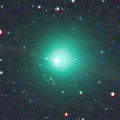
|
It brightened up to 7.9 mag in mid February (Feb. 21, Osamu Miyazaki). Now it is not observable. In the Southern Hemisphere, it will appear in the morning sky in late March at 8 mag, then it stays observable while the comet will be fading. In the Northern Hemisphere, it stays unobservable until May when it becomes fainter than 14 mag.
Date(TT) R.A. (2000) Decl. Delta r Elong. m1 Best Time(A, h)
Mar. 4 0 3.19 3 45.2 0.751 0.374 19 6.7 20:00 ( 86,-12)
Mar. 11 23 32.89 -4 22.3 0.658 0.337 2 6.1 19:49 ( 72,-16)
|
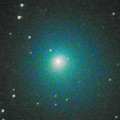
|
Now it is 9.5 mag (Mar. 1, Gabor Santa). Brightening rapidly. It will approach to the earth down to 0.14 a.u. from March to April. It is expected to brighten up to 5-6 mag. It may brighten furthermore in outburst. It is observable in excellent condition in the Northern Hemisphere. In the Southern Hemisphere, it will not be observable for about one month from late March to late April.
Date(TT) R.A. (2000) Decl. Delta r Elong. m1 Best Time(A, h)
Mar. 4 9 48.68 31 15.0 0.205 1.174 150 8.9 23:00 (180, 23)
Mar. 11 10 5.17 39 38.6 0.178 1.135 139 7.8 22:50 (180, 15)
|
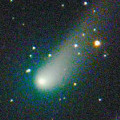
|
Now it is 10.2 mag (Feb. 27, Piotr Guzik). It is expected to brighten up to 6-7 mag from April to July. Recently it is fainter than predicted. In the Northern Hemisphere, it stays observable in good condition until the highlight while the comet will be brightening. In the Southern Hemisphere, it stays extremely low for a while.
Date(TT) R.A. (2000) Decl. Delta r Elong. m1 Best Time(A, h)
Mar. 4 16 19.98 46 17.4 1.668 2.102 101 9.0 4:22 (192, 7)
Mar. 11 16 26.14 46 43.3 1.584 2.047 102 8.8 4:29 (187, 8)
|

|
Now it is 10.7 mag (Mar. 3, Seiichi Yoshida). It is expected to brighten up to 7 mag from April to May. But recently it is fainter than predicted. It locates somewhat low at the high light.
Date(TT) R.A. (2000) Decl. Delta r Elong. m1 Best Time(A, h)
Mar. 4 18 17.82 -23 17.2 1.535 1.504 69 9.2 4:22 (267, 48)
Mar. 11 18 48.37 -22 22.4 1.439 1.429 69 8.8 4:29 (265, 48)
|
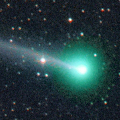
|
It approached to the earth down to 0.08 a.u. in mid February, and brightened up to 6.5 mag (Feb. 10, Danil Sidorko). Now it is fading rapidly. It has already faded down to 9.9 mag (Mar. 3, Osamu Miyazaki).
Date(TT) R.A. (2000) Decl. Delta r Elong. m1 Best Time(A, h)
Mar. 4 11 2.86 25 33.6 0.293 1.272 160 10.9 0:18 (180, 29)
Mar. 11 10 46.08 23 29.3 0.395 1.368 158 12.0 23:28 (180, 32)
|

|
Bright new fragment BT was discovered on Feb. 10. Now the fragment BT is very bright as 11.9 mag (Feb. 23, Chris Wyatt). The primary component is 13.4 mag (Jan. 28, Piotr Guzik). It will be unobservable soon in the Northern Hemisphere. In the Southern Hemisphere, it stays observable for a long time after this.
Date(TT) R.A. (2000) Decl. Delta r Elong. m1 Best Time(A, h)
Mar. 4 19 59.68 -20 56.4 1.385 0.990 45 11.9 4:22 (278, 26)
Mar. 11 20 36.10 -20 13.8 1.401 0.976 44 11.9 4:29 (278, 25)
|
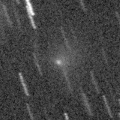
|
Brightening very rapidly. Now it is bright as 12.2 mag (Mar. 1, Gabor Santa). Small comet, but it approaches to the sun down to 0.9 a.u., and to the earth down to 0.5 a.u., and it will brighten up to 12.5 mag in March. It is observable in excellent condition in the Northern Hemisphere. In the Southern Hemisphere, it stays observable only until mid February. Juan Jose Gonzalez reported it is very bright as 10.7 mag on Feb. 24.
Date(TT) R.A. (2000) Decl. Delta r Elong. m1 Best Time(A, h)
Mar. 4 2 30.23 33 55.1 0.615 0.912 64 12.8 20:00 (132, -2)
Mar. 11 2 44.82 42 41.5 0.581 0.913 64 12.6 19:49 (138, -8)
|

|
It has not been observed yet in this apparition. The condition of this apparition is worst. It will brighten up to 10 mag in spring, but not observable at all.
Date(TT) R.A. (2000) Decl. Delta r Elong. m1 Best Time(A, h)
Mar. 4 23 7.83 0 32.9 2.223 1.246 7 13.3 20:00 ( 76,-21)
Mar. 11 23 32.65 2 28.3 2.182 1.201 6 12.9 19:49 ( 79,-20)
|
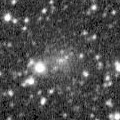
|
New bright comet. Now it is 12.2 mag visually (Mar. 3, Seiichi Yoshida), or 13.8 mag by CCD (Mar. 1, Hidetaka Sato). It stays 13 mag until May. In the Southern Hemisphere, it stays observable for a long time, but it stays low. It will not be observable in early April in the Northern Hemisphere.
Date(TT) R.A. (2000) Decl. Delta r Elong. m1 Best Time(A, h)
Mar. 4 19 21.11 -10 19.5 1.361 1.116 53 13.6 4:22 (263, 28)
Mar. 11 19 59.68 -9 32.0 1.332 1.049 51 13.3 4:29 (263, 27)
|
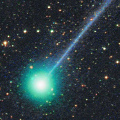
|
It brightened rapidly up to 6.8 mag (Jan. 6, Katsumi Yoshimoto). It approached to the sun down to 0.3 a.u. on Jan. 14. Michael Mattiazzo reported that the comet was visible in the SWAN images from Jan. 19 to Jan. 29 while it faded from 5 mag to 7 mag. It is not observable after this in the Northern Hemisphere. In the Southern Hemisphere, it is observable in the extremely low sky in the evening.
Date(TT) R.A. (2000) Decl. Delta r Elong. m1 Best Time(A, h)
Mar. 4 23 49.98 -28 44.6 2.054 1.232 25 13.5 20:00 ( 59, 6)
Mar. 11 0 12.95 -27 0.8 2.184 1.362 25 14.0 19:49 ( 61, 6)
|

|
Appearing in the morning sky.
Date(TT) R.A. (2000) Decl. Delta r Elong. m1 Best Time(A, h)
Mar. 4 21 0.65 -17 44.2 6.690 5.861 30 13.9 4:22 (284, 12)
Mar. 11 21 5.81 -17 18.2 6.627 5.859 36 13.9 4:29 (279, 17)
|
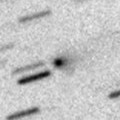
|
Now it is 16.1 mag (Feb. 23, Thomas Lehmann). It will brighten up to 10 mag in summer, and it will be observable in excellent condition in the Southern Hemisphere. It locates low in the Northern Hemisphere.
Date(TT) R.A. (2000) Decl. Delta r Elong. m1 Best Time(A, h)
Mar. 4 15 42.06 -12 16.9 1.385 1.926 107 14.3 4:22 (200, 66)
Mar. 11 15 52.34 -13 2.6 1.288 1.892 111 14.0 4:29 (186, 68)
|

|
Now it is 13.7 mag (Jan. 24, Juan Jose Gonzalez). It is observable in excellent condition in the Northern Hemisphere. It stays low in the Southern Hemisphere.
Date(TT) R.A. (2000) Decl. Delta r Elong. m1 Best Time(A, h)
Mar. 4 11 55.68 32 8.1 1.602 2.516 151 14.2 1:10 (180, 23)
Mar. 11 11 50.74 32 24.1 1.618 2.532 150 14.3 0:37 (180, 23)
|

|
Now it is bright as 14.4 mag (Jan. 14, Thomas Lehmann). It will be observable at 11 mag for a long time from 2017 to 2018. It will be unobservable temporarily soon in the Northern Hemisphere, or in May in the Southern Hemisphere.
Date(TT) R.A. (2000) Decl. Delta r Elong. m1 Best Time(A, h)
Mar. 4 2 56.28 -24 48.2 5.411 4.983 59 14.6 20:00 ( 85, 39)
Mar. 11 2 59.86 -23 25.5 5.425 4.930 55 14.6 19:49 ( 85, 36)
|
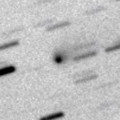
|
Now it is 15.7 mag (Jan. 4, T. Ikemura, H. Sato). It will brighten up to 14 mag from spring to summer. It locates somewhat low in the Northern Hemisphere. The perihelion distance increased from 2.4 a.u. to 2.9 a.u. in this apparition. So it will not be bright as before.
Date(TT) R.A. (2000) Decl. Delta r Elong. m1 Best Time(A, h)
Mar. 4 16 18.84 -18 50.7 2.832 3.116 97 15.0 4:22 (228, 68)
Mar. 11 16 23.30 -19 10.5 2.724 3.105 103 14.9 4:29 (212, 72)
|

|
Now it is 14.3 mag (Dec. 31, Jakub Cerny). It will be unobservable soon.
Date(TT) R.A. (2000) Decl. Delta r Elong. m1 Best Time(A, h)
Mar. 4 1 25.32 -0 52.3 6.046 5.288 37 15.1 20:00 ( 95, 8)
Mar. 11 1 31.32 -0 22.0 6.125 5.307 31 15.2 19:49 ( 94, 5)
|
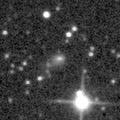
|
Now it is 16.7 mag (Nov. 3, Kunihiro Shima). It will be observable at 13 mag for a long time from 2017 to 2018. It is appearing in the morning sky again.
Date(TT) R.A. (2000) Decl. Delta r Elong. m1 Best Time(A, h)
Mar. 4 19 10.63 0 51.6 5.285 4.823 57 15.2 4:22 (251, 23)
Mar. 11 19 11.49 1 55.2 5.147 4.787 63 15.2 4:29 (244, 29)
|

|
Now it is 15.3 mag (Jan. 31, Alexander Baransky). It stays 15 mag until spring. But it is already unobservable in the Southern Hemisphere. It will be getting lower gradually after this also in the Northern Hemisphere.
Date(TT) R.A. (2000) Decl. Delta r Elong. m1 Best Time(A, h)
Mar. 4 1 38.06 19 58.0 2.209 1.700 47 15.2 20:00 (114, -2)
Mar. 11 1 57.63 21 42.2 2.248 1.703 45 15.2 19:49 (115, -2)
|

|
Now it is 15.6 mag (Jan. 31, Alexander Baransky). It will brighten up to 12-13 mag and will be observable in good condition in summer. Now it is not observable. It will appear in the morning sky in May.
Date(TT) R.A. (2000) Decl. Delta r Elong. m1 Best Time(A, h)
Mar. 4 0 10.18 13 17.9 4.131 3.274 26 15.3 20:00 ( 96,-15)
Mar. 11 0 11.57 13 18.7 4.146 3.236 20 15.2 19:49 ( 94,-19)
|

|
It brightened up to 11 mag from spring to summer in 2016. It is appearing in the morning sky again. It will be observable at 16-17 mag in good condition from spring to summer.
Date(TT) R.A. (2000) Decl. Delta r Elong. m1 Best Time(A, h)
Mar. 4 19 29.78 -19 57.6 3.065 2.582 52 15.8 4:22 (274, 31)
Mar. 11 19 39.85 -19 34.9 3.029 2.623 56 15.8 4:29 (270, 36)
|

|
Now it is 15.6 mag (Jan. 26, Alexander Baransky). It stays 16-17 mag for a long time from 2016 to 2019. It stays near by the equator.
Date(TT) R.A. (2000) Decl. Delta r Elong. m1 Best Time(A, h)
Mar. 4 9 8.20 4 2.7 8.726 9.616 152 15.9 22:19 (180, 51)
Mar. 11 9 7.02 4 22.8 8.775 9.611 145 15.9 21:50 (180, 51)
|

|
Now it is 15.6 mag (Jan. 9, J. L. Martin). It stays observable at 16 mag in good condition until spring. It locates low in the Southern Hemisphere.
Date(TT) R.A. (2000) Decl. Delta r Elong. m1 Best Time(A, h)
Mar. 4 6 43.24 27 43.6 3.167 3.712 116 15.9 20:00 (179, 27)
Mar. 11 6 44.25 27 40.9 3.255 3.705 109 15.9 19:49 (175, 27)
|

|
It was observed at 16 mag from spring to summer in 2016. It will be observable at 16 mag also in 2017 from winter to spring.
Date(TT) R.A. (2000) Decl. Delta r Elong. m1 Best Time(A, h)
Mar. 4 17 59.87 -1 48.6 3.440 3.317 74 16.1 4:22 (240, 38)
Mar. 11 18 6.17 -0 3.7 3.367 3.335 79 16.1 4:29 (231, 42)
|
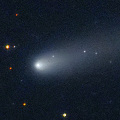
|
It brightened up to 11-12 mag from summer to autumn. Now it is fading.
Date(TT) R.A. (2000) Decl. Delta r Elong. m1 Best Time(A, h)
Mar. 4 12 12.72 -27 12.6 1.540 2.399 141 16.2 1:27 (180, 82)
Mar. 11 12 5.76 -26 33.1 1.547 2.447 148 16.3 0:52 (180, 82)
|

|
It has not been observed yet in this apparition. It will brighten up to 12 mag in summer. It will be observable in excellent condition in the Southern Hemisphere. It locates somewhat low in the Northern Hemisphere.
Date(TT) R.A. (2000) Decl. Delta r Elong. m1 Best Time(A, h)
Mar. 4 17 48.76 -32 47.9 2.537 2.490 75 16.4 4:22 (278, 57)
Mar. 11 18 1.07 -33 0.1 2.427 2.462 80 16.2 4:29 (276, 62)
|

|
It stayed bright 12 mag for a long time from autum in 2015 to summer in 2016. Now it is fading. It has already faded dwon to 15.6 mag (Jan. 6, Hiroshi Abe).
Date(TT) R.A. (2000) Decl. Delta r Elong. m1 Best Time(A, h)
Mar. 4 17 24.84 -6 55.1 4.466 4.451 82 16.3 4:22 (236, 48)
Mar. 11 17 24.95 -7 17.1 4.401 4.503 89 16.4 4:29 (226, 54)
|

|
Now it is 17.0 mag (Mar. 2, Thomas Lehmann). It is expected to brighten up to 9 mag in summer in 2018. In the Northern Hemisphere, it stays observable until 2018 summer while the comet will be brightening. In the Southern Hemisphere, it is hardly observable in 2017, but it will be observable in good condition in 2018.
Date(TT) R.A. (2000) Decl. Delta r Elong. m1 Best Time(A, h)
Mar. 4 19 2.82 46 22.9 5.934 5.746 74 16.5 4:22 (216, -7)
Mar. 11 19 6.13 46 54.6 5.850 5.690 75 16.4 4:29 (212, -4)
|

|
Now it is 16.5 mag (Jan. 26, Alexander Baransky). It stays 16 mag for a long time from 2017 to 2018.
Date(TT) R.A. (2000) Decl. Delta r Elong. m1 Best Time(A, h)
Mar. 4 8 39.89 -0 45.1 4.840 5.678 144 16.5 21:50 (180, 56)
Mar. 11 8 34.64 0 35.1 4.889 5.660 137 16.5 21:17 (180, 54)
|
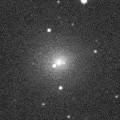
|
It brightened up to 11-12 mag in autumn. Now it is fading.
Date(TT) R.A. (2000) Decl. Delta r Elong. m1 Best Time(A, h)
Mar. 4 13 52.77 -16 40.3 1.617 2.388 131 16.5 3:06 (180, 72)
Mar. 11 13 49.07 -16 21.8 1.600 2.438 138 16.7 2:35 (180, 71)
|

|
Now it is 16.5 mag (Dec. 29, Sandor Szabo). It will brighten up to 15 mag and will be observable in good condition from autum to winter in 2017. In the Northern Hemisphere, it becomes unobservable temporarily from April to May, but it stays observable in good condition for a long time after that while the comet will be brightening. It is not observable until summer in the Southern Hemisphere.
Date(TT) R.A. (2000) Decl. Delta r Elong. m1 Best Time(A, h)
Mar. 4 1 56.06 37 18.8 5.300 4.884 60 16.5 20:00 (130, -9)
Mar. 11 1 58.22 36 31.1 5.375 4.857 53 16.5 19:49 (127,-11)
|

|
Now it is 16.5 mag (Dec. 26, A. Diepvens). It stays 16.5 mag from 2016 to 2017. In the Northern Hemisphere, it stays observable in good condition for a long time. In the Southern Hemisphere, it will never be observable again.
Date(TT) R.A. (2000) Decl. Delta r Elong. m1 Best Time(A, h)
Mar. 4 18 42.36 44 47.9 6.422 6.271 76 16.6 4:22 (215, -3)
Mar. 11 18 47.02 46 12.4 6.393 6.275 78 16.6 4:29 (210, -1)
|

|
It brightened up to 6 mag from autumn in 2015 to early 2016. Now it is fading. It has already faded down to 16.0 mag (Jan. 1, Yuji Ohshima). It is observable in good condition in the Northern Hemisphere. It is not observable after this in the Southern Hemisphere.
Date(TT) R.A. (2000) Decl. Delta r Elong. m1 Best Time(A, h)
Mar. 4 2 57.62 44 38.5 6.176 5.978 73 16.7 20:00 (143, -5)
Mar. 11 2 59.93 44 13.6 6.345 6.043 67 16.8 19:49 (141, -7)
|

|
It has not been observed since last April. Now it is fading. But it must be bright as 17 mag still now.
Date(TT) R.A. (2000) Decl. Delta r Elong. m1 Best Time(A, h)
Mar. 4 17 2.22 -20 13.4 2.746 2.869 86 16.8 4:22 (247, 61)
Mar. 11 17 6.10 -19 55.8 2.715 2.940 93 16.9 4:29 (236, 66)
|
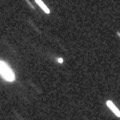
|
Now it is 17.1 mag (Jan. 9, ATLAS-HKO, Haleakala). It brightened rapidly, and became brighter than originally expected. It stays 17 mag until 2017. In the Northern Hemisphere, it stays observable in excellent condition for a long time. It is not observable in the Southern Hemisphere.
Date(TT) R.A. (2000) Decl. Delta r Elong. m1 Best Time(A, h)
Mar. 4 12 57.98 61 14.1 6.836 7.395 120 16.9 2:12 (180, -6)
Mar. 11 12 47.98 61 26.9 6.853 7.403 120 17.0 1:34 (180, -6)
|

|
It brightened up to 15 mag in early 2016. Now it is fading. It has already faded down to 16.3 mag (Dec. 30, Sandor Szabo). In the Northern Hemisphere, it stays observable in good condition for a long time until autumn when the comet will be fainter than 18 mag. It will never be observable after this in the Southern Hemisphere.
Date(TT) R.A. (2000) Decl. Delta r Elong. m1 Best Time(A, h)
Mar. 4 15 30.93 70 52.9 6.131 6.431 103 17.0 4:22 (182,-16)
Mar. 11 15 25.67 71 21.4 6.168 6.461 102 17.1 4:11 (180,-16)
|

|
It will pass the perihelion in 2019. However, it has not been brightening since the discovery in 2010. Now it is 17.1 mag (Jan. 4, T. Ikemura, H. Sato). It stays observable in excellent condition in the Northern Hemisphere. It is not observable in the Southern Hemisphere.
Date(TT) R.A. (2000) Decl. Delta r Elong. m1 Best Time(A, h)
Mar. 4 3 46.17 60 10.9 9.455 9.453 86 17.3 20:00 (159,-12)
Mar. 11 3 48.86 60 2.7 9.527 9.435 81 17.3 19:49 (157,-13)
|
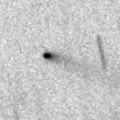
|
Now it is 16.9 mag (Feb. 1, Alexander Baransky). It was observed at 17 mag last winter. It will be observable at 17 mag again next winter. It is observable in good condition in the Northern Hemisphere. But it locates low in the Southern Hemisphere.
Date(TT) R.A. (2000) Decl. Delta r Elong. m1 Best Time(A, h)
Mar. 4 11 12.69 37 56.4 3.279 4.156 148 17.3 0:27 (180, 17)
Mar. 11 11 8.86 39 13.5 3.337 4.185 144 17.3 23:51 (180, 16)
|
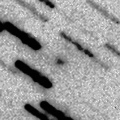
|
Now it is 17.2 mag (Dec. 30, A. Diepvens). In the Northern Hemisphere, it is observable at 17-18 mag until March. It is not observable in the Southern Hemisphere.
Date(TT) R.A. (2000) Decl. Delta r Elong. m1 Best Time(A, h)
Mar. 4 17 20.81 79 0.5 1.722 2.066 95 17.3 4:22 (187,-25)
Mar. 11 15 27.95 82 52.2 1.729 2.100 97 17.4 4:16 (180,-28)
|

|
Now it is 18.2 mag (Dec. 6, T. Ikemura, H. Sato). It was expected to be observable at 17 mag in good condition in winter. But actually, it is fainter than this ephemeris.
Date(TT) R.A. (2000) Decl. Delta r Elong. m1 Best Time(A, h)
Mar. 4 12 42.84 2 2.8 1.826 2.750 153 17.4 1:57 (180, 53)
Mar. 11 12 38.35 2 56.9 1.821 2.781 161 17.5 1:25 (180, 52)
|

|
Now it is 16.1 mag (Dec. 30, Yuji Ohshima). It is observable in excellent condition in the Northern Hemisphere. It locates low in the Southern Hemisphere. It will be fainter than 18 mag in April.
Date(TT) R.A. (2000) Decl. Delta r Elong. m1 Best Time(A, h)
Mar. 4 6 43.74 33 1.7 2.950 3.494 115 17.4 20:00 (179, 22)
Mar. 11 6 46.36 32 37.0 3.051 3.506 109 17.5 19:49 (176, 22)
|
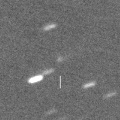
|
Now it is 17.4 mag (Jan. 25, Alexander Baransky). It is observable at 17.5 mag in good condition from winter to spring.
Date(TT) R.A. (2000) Decl. Delta r Elong. m1 Best Time(A, h)
Mar. 4 15 7.91 -11 29.6 1.794 2.394 115 17.5 4:21 (180, 67)
Mar. 11 15 10.23 -11 38.0 1.735 2.411 121 17.6 3:56 (180, 67)
|
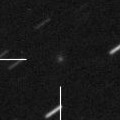
|
Now it is 17.3 mag (Jan. 8, CAO, San Pedro de Atacama). It is observable in good condition in the Southern Hemisphere.
Date(TT) R.A. (2000) Decl. Delta r Elong. m1 Best Time(A, h)
Mar. 4 5 47.07 -30 44.4 3.622 3.869 96 17.7 20:00 (105, 76)
Mar. 11 5 45.72 -27 56.0 3.694 3.873 92 17.7 19:49 (107, 71)
|

|
It brightened up to 8-9 mag from winter to spring in 2016. Now it is fading. It has already faded down to 17.1 mag (Dec. 6, T. Ikemura, H. Sato).
Date(TT) R.A. (2000) Decl. Delta r Elong. m1 Best Time(A, h)
Mar. 4 12 52.56 -15 55.6 4.308 5.143 143 17.8 2:07 (180, 71)
Mar. 11 12 46.96 -16 6.0 4.305 5.200 151 17.9 1:33 (180, 71)
|
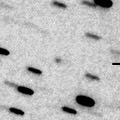
|
Now it is 18.9 mag (Dec. 27, K. Hills). It is observable at 18 mag in good condition from January to March.
Date(TT) R.A. (2000) Decl. Delta r Elong. m1 Best Time(A, h)
Mar. 4 10 27.91 -8 24.0 2.289 3.251 163 17.9 23:38 (180, 63)
Mar. 11 10 23.57 -8 13.4 2.319 3.272 160 18.0 23:06 (180, 63)
|
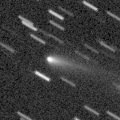
|
It brightened up to 14.6 mag from autum to winter (Dec. 2, Kunihiro Shima). Now it is fading. It has already faded down to 16.9 mag (Jan. 31, Alexander Baransky). It will be fainter than 18 mag in March.
Date(TT) R.A. (2000) Decl. Delta r Elong. m1 Best Time(A, h)
Mar. 4 4 36.91 30 24.3 2.890 3.033 88 17.9 20:00 (151, 18)
Mar. 11 4 44.99 30 19.4 3.011 3.060 83 18.1 19:49 (149, 17)
|

|
Very far object. Outburst occured on Feb. 20, 2015, and it brightened up to 15 mag. Now it is 17.8 mag (June 4, Space Surveillance Telescope, Atom Site). It is observable in excellent condition in the Southern Hemisphere. It locates low in the Northern Hemisphere.
Date(TT) R.A. (2000) Decl. Delta r Elong. m1 Best Time(A, h)
Mar. 4 14 43.65 -26 44.5 8.877 9.358 116 18.0 3:57 (180, 82)
Mar. 11 14 43.17 -26 43.6 8.783 9.363 123 17.9 3:29 (180, 82)
|
|
![]()
 C/2017 E1 ( Borisov )
C/2017 E1 ( Borisov ) C/2016 U1 ( NEOWISE )
C/2016 U1 ( NEOWISE ) 29P/Schwassmann-Wachmann 1
29P/Schwassmann-Wachmann 1 71P/Clark
71P/Clark 315P/2013 V6 ( LONEOS )
315P/2013 V6 ( LONEOS ) C/2016 R2 ( PanSTARRS )
C/2016 R2 ( PanSTARRS ) 65P/Gunn
65P/Gunn C/2011 KP36 ( Spacewatch )
C/2011 KP36 ( Spacewatch ) C/2015 O1 ( PanSTARRS )
C/2015 O1 ( PanSTARRS ) 93P/Lovas 1
93P/Lovas 1 C/2015 VL62 ( Lemmon-Yeung-PanSTARRS )
C/2015 VL62 ( Lemmon-Yeung-PanSTARRS ) 81P/Wild 2
81P/Wild 2 C/2014 B1 ( Schwartz )
C/2014 B1 ( Schwartz ) 74P/Smirnova-Chernykh
74P/Smirnova-Chernykh C/2016 B1 ( NEOWISE )
C/2016 B1 ( NEOWISE ) 43P/Wolf-Harrington
43P/Wolf-Harrington 213P/Van Ness
213P/Van Ness C/2014 W2 ( PanSTARRS )
C/2014 W2 ( PanSTARRS ) C/2016 M1 ( PanSTARRS )
C/2016 M1 ( PanSTARRS ) C/2016 A1 ( PanSTARRS )
C/2016 A1 ( PanSTARRS ) 144P/Kushida
144P/Kushida C/2015 V1 ( PanSTARRS )
C/2015 V1 ( PanSTARRS ) C/2014 OE4 ( PanSTARRS )
C/2014 OE4 ( PanSTARRS ) C/2013 US10 ( Catalina )
C/2013 US10 ( Catalina ) C/2015 TQ209 ( LINEAR )
C/2015 TQ209 ( LINEAR ) C/2014 R3 ( PanSTARRS )
C/2014 R3 ( PanSTARRS ) C/2013 V4 ( Catalina )
C/2013 V4 ( Catalina ) C/2010 U3 ( Boattini )
C/2010 U3 ( Boattini ) C/2015 X7 ( ATLAS )
C/2015 X7 ( ATLAS ) C/2016 T2 ( Matheny )
C/2016 T2 ( Matheny ) 118P/Shoemaker-Levy 4
118P/Shoemaker-Levy 4 P/2015 TP200 ( LINEAR )
P/2015 TP200 ( LINEAR ) 94P/Russell 4
94P/Russell 4 C/2017 A3 ( Elenin )
C/2017 A3 ( Elenin ) C/2014 S2 ( PanSTARRS )
C/2014 S2 ( PanSTARRS ) 330P/2015 U1 ( Catalina )
330P/2015 U1 ( Catalina ) 56P/Slaughter-Burnham
56P/Slaughter-Burnham C/2013 C2 ( Tenagra )
C/2013 C2 ( Tenagra )![]()











































